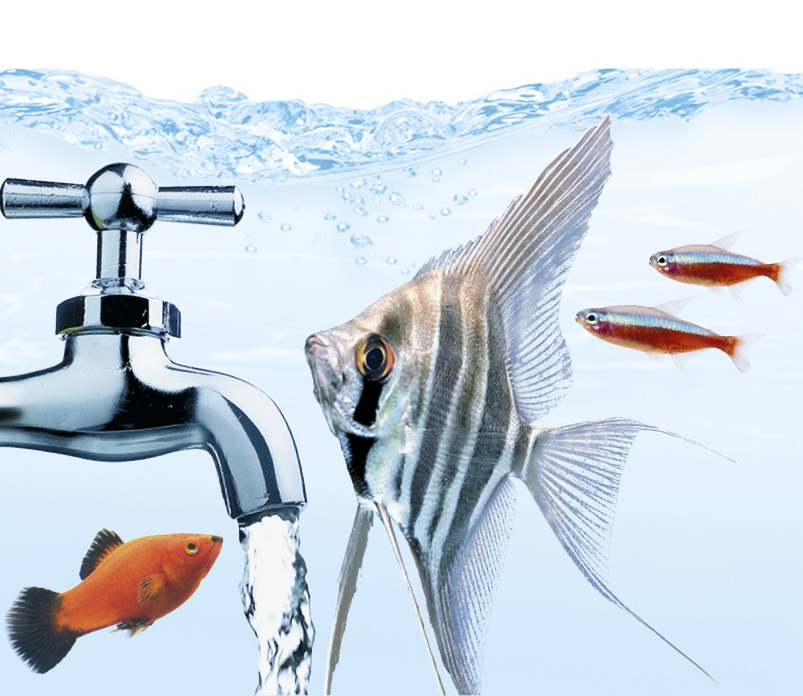It is a well-known fact that every aquarist needs to regularly test the condition of their aquarium water. Poor water conditions are always a sign that the optimal biological balance has been disrupted and that the aquarium system is not functioning correctly. Water tests provide security, allowing for early identification of any imbalances and guarding against damage. The relevant water value can be precisely determined by comparing the sample to the colour chart or by counting the number of drops it takes to change the sample’s colour. Tetra Water Tests are available individually, as refills or in sets. The following overview gives information on the different Tetra test products:
Quick and easy testing
Tetra Test 6in1With Tetra 6in1 test strips, aquarists can check six key water values, namely the pH value, the carbonate and total hardness, as well as the nitrite, nitrate and chlorine content, both quickly and simply in one easy step. This method means that less dedicated aquarium owners can monitor the water values with the minimum amount of effort. Conversely, aquarium enthusiasts can use this method as a preliminary test before deciding which liquida tests need to be conducted. Further improvements have been made to Tetra 6in1 strips – they now keep for up to three years!
Total hardness
Water hardness has a significant effect on the organic functions of aquatic life. There is a difference between total hardness, formed by alkaline earth salts, and carbonate hardness, which serves to buffer the pH value. Total hardness is measured by determining the quantity of both calcium and magnesium salts. A high proportion of these results in hard water, whilst soft water contains a small quantity.
Carbonate hardness
Alongside calcium and magnesium salts, almost all water also contains additional salt ingredients, such as bicarbonate. The water’s carbonate hardness and pH value are interdependent. The presence of bicarbonate is important in an aquarium, acting as a buffer and preventing excessive or rapid modifications to the pH value.
pH value
Chemically pure water has a pH value of 7 and is described as neutral. At this value, there is a perfect balance between acids and alkalis. The higher the proportion of acids in the water, the greater the pH value moves below 7. Equally, the more alkalis in the water, the more the value moves above 7. The pH value is a logarithmic scale, meaning that a change in the value from 6.5 to 7.5 equates to a tenfold increase. Since all fish, plants and microorganisms are highly sensitive to changes in the pH value, it should be tested at least once a week.
Ammonium/ammonia (NH4+/NH3)
The first stage in the decomposition of organic nitrogenous substances such as fish waste, uneaten food and plant remains generates toxic ammonia (NH3) and non-toxic ammonium (NH4+). Both ammonium and ammonia are balanced in terms of pH values. The rule is that a high pH value (>8.5) means a greater level of toxic ammonia, whereas a low pH value (<7.5) means more non-toxic ammonium. To avoid damaging the fish, steps need to be taken to ensure that, on the one hand, the pH value is appropriate and, on the other hand, that the concentration of ammonia is generally kept as low as possible. The ammonia concentration in a biologically sound aquarium is so low that it is barely detectable.
Nitrite (NO2-)
Toxic nitrite is broken down into non-toxic nitrate during the nitrate cycle’s second stage of decomposition by bacteria, such as those from the nitrospira genus. Nitrite is a nitrogen compound that is formed as a result of decomposition processes in the aquarium. High levels of this indicate that there is a problem with the biological filter system. The nitrite content should ideally be less than 0.3 mg/l and thus not measurable. The aquarium water must be checked weekly to detect dangerous nitrite concentrations early.
Nitrate (NO3-)
The nitrate test allows you to accurately determine the extent of aquarium water contamination. Measuring the nitrate value indicates when and how much water needs to be changed. Organic nitrogenous substances such as fish waste, uneaten food and dead plant material are broken down in a number of different stages by specific microorganisms. Nitrate is a nutritive substance for plants, but in concentrations of more than 50 mg/l, it is increasingly dangerous for fish and promotes the growth of unsightly algae.
Phosphate (PO4)
Phosphate occurs in only very low quantities in natural waters. Organic phosphate-containing material such as fish waste, uneaten food and decomposing plants are broken down into phosphate by specific microorganisms. Phosphate is an important nutrient for plants that accumulates continuously. However, an excessive phosphate concentration coupled with high nitrate levels can lead to unwelcome algae growth. The level of phosphate in aquarium water should be as low as possible, preferably less than 2 mg/l.
Iron (Fe)
In addition to nitrate and phosphate, trace elements such as iron are also essential nutrients for healthy aquarium plant growth. Iron promotes the formation of chlorophyll, which gives leaves their green colour. The concentration of iron in the aquarium should be between 0.25 mg/l and 0.5 mg/l. This level is suitable for all aquatic plants. Plants may stop growing and leaves may turn yellow if the level of iron is below 0.1 mg/l for an extended period of time.
Carbon dioxide (CO2)
CO2 provides an essential basis for aquatic plant nourishment and growth. However, high concentrations of CO2 can pose a risk for tropical fish. The optimal permanent concentration in aquarium water is between 5 mg/l and 15 mg/l.
Oxygen (O2)
Oxygen is crucial for the survival of fish and plants. During the daytime, aquarium plants absorb carbon dioxide and emit oxygen through the process of photosynthesis. Fish absorb oxygen through their gills to breathe. Even microorganisms require oxygen to survive, particularly the essential filter bacteria and any roots that may be present. Conversely, at night the aquatic plants emit CO2 and absorb oxygen. This means that the oxygen level in the non-aerated aquarium is lower in the morning than in the evening, possibly even drastically low. In the long-run, a lack of oxygen can lead to tropical fish becoming more susceptible to disease. It is thus recommended that the aquarium is aerated throughout the night.

